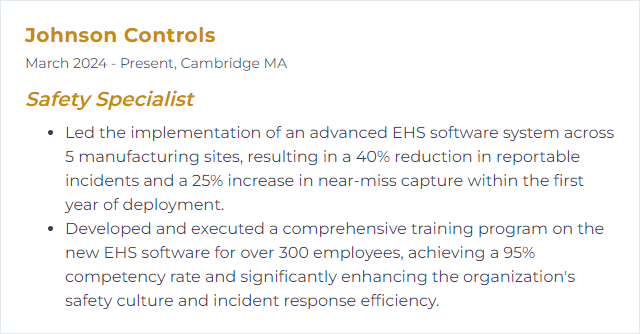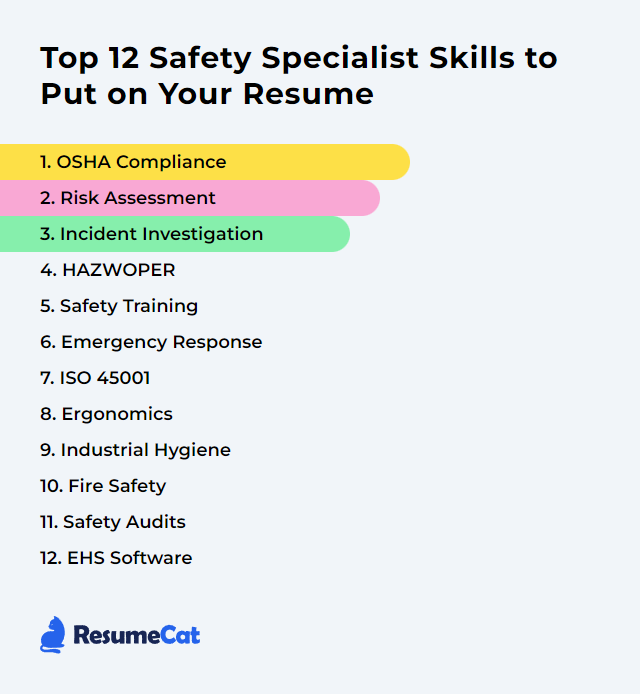Top 12 Safety Specialist Skills to Put on Your Resume
In today's job market, safety specialists get noticed when they show sharp, proven skills that keep people and operations out of harm’s way. This guide digs into the 12 core skills every safety specialist should highlight on a resume—signals to employers that you can spot hazards early, cut risk down to size, and build a culture where safety actually sticks.
Safety Specialist Skills
- OSHA Compliance
- Risk Assessment
- Incident Investigation
- HAZWOPER
- Safety Training
- Emergency Response
- ISO 45001
- Ergonomics
- Industrial Hygiene
- Fire Safety
- Safety Audits
- EHS Software
1. OSHA Compliance
OSHA compliance means following the Occupational Safety and Health Administration’s standards to protect workers from injuries, illnesses, and long-term harm. For a Safety Specialist, that translates to putting the rules into practice, verifying they work, and correcting gaps before they bite.
Why It's Important
It anchors your program. Standardized protocols, fewer hazards, fewer fines and lawsuits. Most important—people go home safe.
How to Improve OSHA Compliance Skills
Make it an engine, not a checklist. Start with awareness and keep tuning:
Stay Informed: Track updates to OSHA standards and interpretations; know your applicable state plan requirements too.
Regular Audits: Run thorough audits and corrective action cycles. Verify controls, not just paperwork.
Targeted Training: Train workers and supervisors on the exact hazards they face and the procedures that matter.
Program Design: Build written programs that match your operations—lockout/tagout, confined space, machine guarding, PPE, and more.
Worker Engagement: Use safety committees, toolbox talks, and near-miss reporting to surface real issues.
Investigate: Probe incidents and near-misses for root causes, then fix systems—not just symptoms.
Recordkeeping: Keep OSHA logs accurate and current; review trends and act on them.
Proactive Culture: Benchmark, share lessons, and adapt quickly. Don’t wait for citations to force change.
Done well, compliance becomes the floor you stand on—not the ceiling you bump into.
How to Display OSHA Compliance Skills on Your Resume
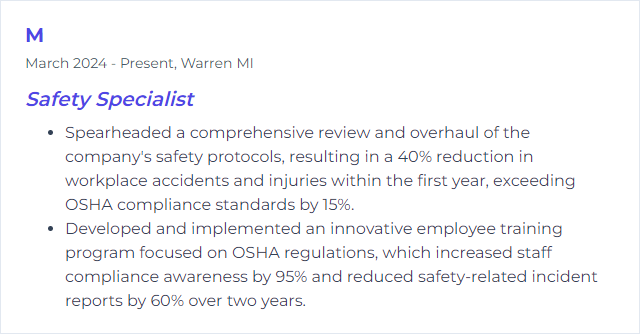
2. Risk Assessment
Risk assessment spots hazards, estimates likelihood and impact, and guides controls that prevent injuries, illnesses, and downtime.
Why It's Important
It turns uncertainty into action. You prioritize what matters, comply with law, and deploy resources where they pay off.
How to Improve Risk Assessment Skills
Build a disciplined, repeatable method:
Know the Standards: Align with recognized practices across your industry.
Hazard Identification: Inspect, observe, and listen to workers. Use tools like task analyses and checklists.
Risk Evaluation: Use a clear risk matrix to rank severity and probability—consistency beats guesswork.
Hierarchy of Controls: Favor elimination and engineering before administrative controls and PPE.
Monitor and Review: Update assessments after changes, incidents, or new data. Risk isn’t static.
Train and Communicate: Make risks visible and understandable; confirm people know their controls.
Leverage Tech: Digital checklists, inspection apps, and dashboards tighten the loop.
How to Display Risk Assessment Skills on Your Resume

3. Incident Investigation
A structured process to capture facts, find root causes, and lock in fixes after incidents or near-misses.
Why It's Important
Prevents repeats. Protects people. Shields operations. You learn once and improve everywhere.
How to Improve Incident Investigation Skills
Precision matters. Speed too.
Preparation: Know site operations, roles, and hazards. Have kits, forms, and a plan ready.
Immediate Response: Secure the area, care for people, preserve evidence.
Data Collection: Photos, measurements, documents. Structured interviews that avoid blame and dig for facts.
Analysis: Use methods like 5 Whys, fishbone, or TapRooT to surface system causes.
Clear Reports: Concise findings, specific corrective actions, owners, and deadlines.
Follow-Through: Verify actions, audit effectiveness, and share lessons across teams.
Reference solid frameworks—such as those aligned to ISO 45001—and make closure measurable.
How to Display Incident Investigation Skills on Your Resume

4. HAZWOPER
HAZWOPER covers hazardous waste operations and emergency response—training, controls, and oversight that keep people safe around dangerous substances.
Why It's Important
Because hazardous work leaves no margin. Strong programs prevent exposures, runaway events, and environmental damage.
How to Improve HAZWOPER Skills
Keep the edge sharp:
Current Knowledge: Track 29 CFR 1910.120 requirements and related guidance.
Advanced Training: Maintain refreshers; add scenario-based modules for realism.
Hands-On Drills: Practice entry, monitoring, decon, spill control, and command roles.
Plans and Protocols: Update emergency response plans, site safety plans, and SOPs regularly.
Equipment Readiness: Inspect PPE, meters, and decon gear on a routine schedule.
Medical Surveillance: Monitor worker health tied to exposure risks and tasks.
External Coordination: Align with local responders; run joint exercises.
Feedback Loops: Encourage reporting and suggestions—psychological safety matters.
How to Display HAZWOPER Skills on Your Resume
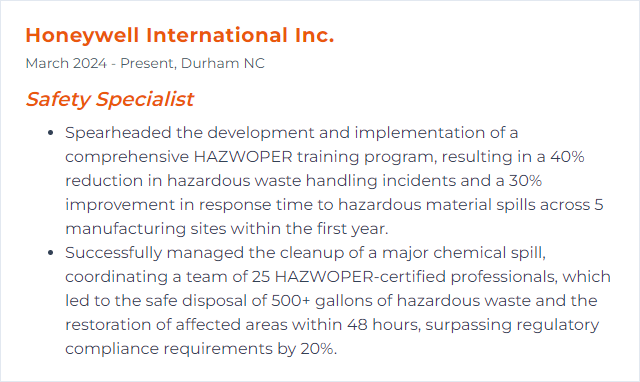
5. Safety Training
Teaching people how to work safely—procedures, behaviors, and decisions that reduce harm.
Why It's Important
Knowledge changes actions. Good training lowers incident rates and empowers workers to spot and stop risk.
How to Improve Safety Training Skills
Make it vivid, relevant, and continuous:
Engagement: Use interactive elements—quizzes, simulations, short scenarios. Gamify with tools like Kahoot! when appropriate.
Job-Specific Content: Tailor examples to actual tasks. Pull in OSHA and industry guidance that matches your hazards.
Blended Learning: Mix instructor-led sessions, microlearning, and e-learning platforms such as LinkedIn Learning.
Feedback: Gather input with simple surveys to refine content and cadence.
Professional Community: Stay active with groups like ASSP to keep content fresh and credible.
How to Display Safety Training Skills on Your Resume
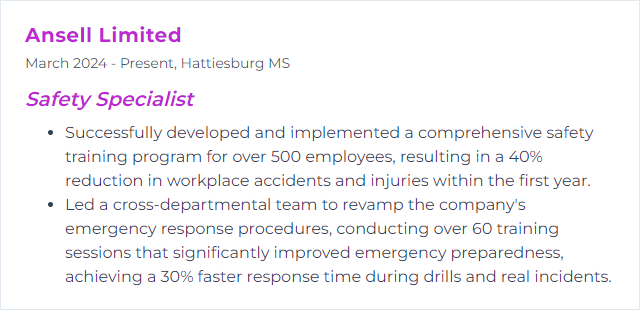
6. Emergency Response
Coordinated, immediate actions that limit harm during crises—medical events, fires, chemical releases, severe weather, and more.
Why It's Important
Seconds count. Prepared teams save lives, protect assets, and restore operations faster.
How to Improve Emergency Response Skills
Plan hard. Drill harder.
Risk and Impact Analysis: Identify plausible scenarios and critical functions at risk.
Training and Drills: Run realistic exercises—tabletop, functional, and full-scale. Rotate roles.
Communication: Define internal notifications, external contacts, and backup channels.
Technology: Use emergency management software and mass notification tools for speed and accountability.
Community Ties: Coordinate with local responders; share site layouts and hazards in advance.
After-Action Reviews: Capture lessons learned and close gaps quickly.
How to Display Emergency Response Skills on Your Resume

7. ISO 45001
The global standard for occupational health and safety management systems—structured, proactive, and focused on continual improvement.
Why It's Important
It hardwires risk prevention into daily operations, boosting safety performance and compliance in a way that sustains.
How to Improve ISO 45001 Skills
Work the system—then let the system work for you:
Gap Analysis: Compare current practices to ISO 45001 requirements and prioritize fixes.
Employee Involvement: Build participation into hazard identification, controls, and reviews.
Risk-Based Thinking: Continually identify, assess, and control hazards with measurable objectives.
Leadership Commitment: Secure resources and visible support; leaders should model safe behaviors.
Performance Monitoring: Track leading and lagging indicators. Make dashboards count.
Continual Improvement: Audit routinely; use the PDCA cycle to drive corrective and preventive actions.
Legal Compliance: Maintain a live register of applicable requirements and proof of conformity.
Incident Management: Investigate, learn, and integrate changes into the management system.
How to Display ISO 45001 Skills on Your Resume
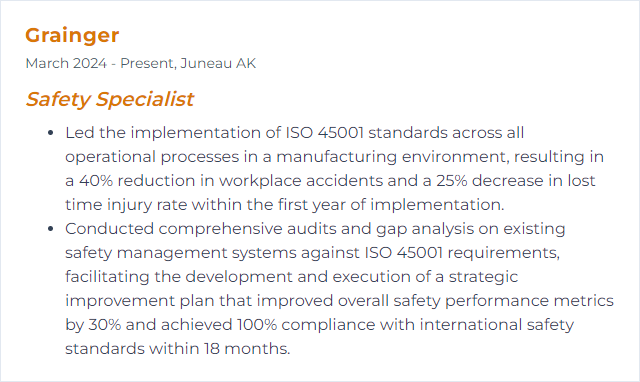
8. Ergonomics
Designing work to fit people—reducing strain, improving comfort, and lifting productivity.
Why It's Important
Fewer musculoskeletal injuries, smoother workflows, happier teams. Waste drops, quality climbs.
How to Improve Ergonomics Skills
Focus on fit, movement, and recovery:
Assess Workstations: Use tools like RULA and task analysis to flag risk factors.
Adjustability: Provide adjustable chairs, desks, monitor heights, and lighting.
Right Tools: Introduce ergonomic peripherals and job aids—vertical mice, lift assists, anti-fatigue mats where needed.
Training: Coach posture, setup, manual handling, and microbreak routines.
Breaks: Encourage short, frequent pauses; techniques like time-blocking help.
Stretch and Strengthen: Simple routines that target high-load muscle groups.
How to Display Ergonomics Skills on Your Resume
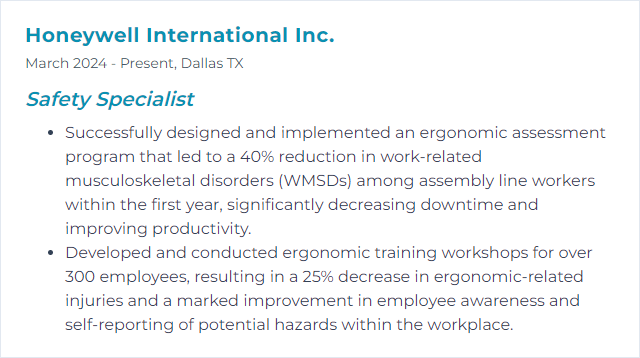
9. Industrial Hygiene
Anticipating, recognizing, evaluating, and controlling chemical, physical, biological, and ergonomic hazards.
Why It's Important
It protects long-term health, prevents occupational disease, and ensures regulatory compliance—quietly powerful, endlessly essential.
How to Improve Industrial Hygiene Skills
Think lifecycle: assess, control, verify, refine.
Risk Assessment: Survey operations for exposures—air sampling, noise dosimetry, surface testing, and job hazard analyses.
Hierarchy of Controls: Prioritize elimination and substitution; add engineering, admin controls, then PPE.
Training: Teach exposure risks, signs and symptoms, and correct control use.
Monitoring and Maintenance: Track exposures and health indicators; keep controls and PPE in top condition. Use recognized frameworks to gauge program effectiveness.
Continuous Improvement: Update procedures with new science and technology. Engage with AIHA and similar bodies.
Emergency Preparedness: Plan for releases, spills, or biological events, and drill those plans.
How to Display Industrial Hygiene Skills on Your Resume
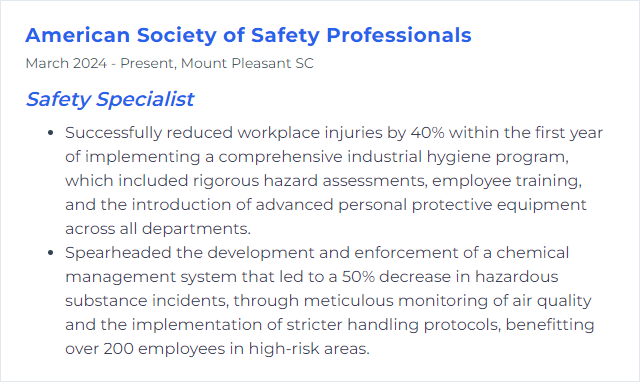
10. Fire Safety
Prevention, detection, and response measures that stop fires from starting—and limit damage if they do.
Why It's Important
Lives and livelihoods depend on it. Fire safety keeps people safe, preserves assets, and maintains continuity.
How to Improve Fire Safety Skills
Cover the basics, then go deeper:
Fire Risk Assessments: Identify ignition sources, fuels, and vulnerable areas; act on the findings.
Training: Teach extinguisher types and use, alarm protocols, and evacuation roles. Refresh often.
Detection Systems: Install and test alarms and detectors on a defined schedule per recognized standards.
Suppression: Ensure the right extinguishers, maintained sprinklers, and accessible hose stations.
Evacuation: Keep routes clear and marked; drill to reduce confusion and time to exit.
Electrical Safety: Inspect wiring, panels, and equipment to prevent hidden ignition sources.
Hazardous Materials: Store and handle flammables properly; label and segregate.
Policies: Enforce hot work permits, smoking rules, and housekeeping standards.
How to Display Fire Safety Skills on Your Resume

11. Safety Audits
Top-to-bottom evaluations that check compliance, find hazards, and pressure-test your safety management system.
Why It's Important
Audits expose blind spots and drive improvements before incidents do the same job more brutally.
How to Improve Safety Audits Skills
Structure, objectivity, and follow-up—non-negotiables.
Know the Bar: Stay current on regulations, consensus standards, and internal requirements.
Engage People: Involve workers and supervisors; they know where risk hides.
Digital Tools: Use audit software for checklists, photo evidence, and action tracking.
Plan the Scope: Define criteria, sampling methods, and timelines clearly.
Inspect Deeply: Document thoroughly—conditions, behaviors, and systemic causes.
Actionable Reports: Assign owners, due dates, and verification steps. Keep it readable.
Close the Loop: Verify corrective actions, then re-audit critical areas.
Targeted Training: Feed findings into training and coaching plans.
Benchmark: Compare against industry data and internal sites to spot trends.
Seek Feedback: Improve the audit process itself with post-audit input.
How to Display Safety Audits Skills on Your Resume
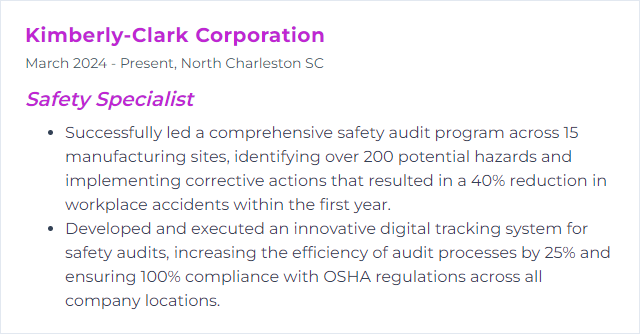
12. EHS Software
Digital platforms that centralize safety programs—incidents, inspections, training, actions, analytics, and compliance.
Why It's Important
It accelerates insight and consistency. Better data. Faster decisions. Stronger accountability.
How to Improve EHS Software Skills
Make the tool work for the people, not the other way around:
Simple UX: Streamlined screens and workflows reduce clicks and errors.
Mobile First: Enable offline capture, photo uploads, and quick entries in the field.
Customization and Scale: Tailor forms, fields, and automation to your operations as they grow.
Integrations: Connect HR, maintenance, and operations systems for clean data flow and holistic analytics.
Reporting: Build dashboards that spotlight trends, leading indicators, and overdue actions.
Compliance Updates: Keep regulatory content current; map requirements to controls and tasks.
Security: Protect sensitive data with strong access controls and audit trails.
Support and Iteration: Provide training, gather feedback, and release continuous improvements.
How to Display EHS Software Skills on Your Resume
